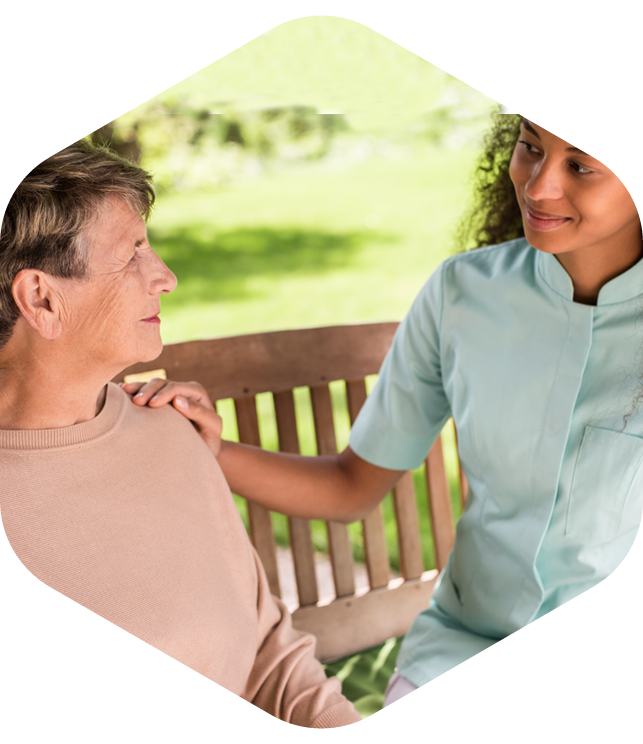How Social Support Networks Can Help People with Cancer
The stronger the social support network’s connection is, the more significant is its help.1

Cancer patients need to adapt to their new reality and deal with numerous physical, psychological and social issues during the different stages of treatment.1 Because of that, they may need support to cope and have more quality of life. Those who have a strong social support network are more likely to stay positive and manage the challenges the disease brings.2
What is the social support network and what is it for?
The social support network consists of the patient’s family members, friends and neighbors, as well as health systems, religious organizations, etc. The support comes from the relationships and bonds between people.1
Social support - Could be defined by the information and resources from the social support network, which can bring physical, emotional and behavioral benefits, both for the person with cancer and those close to them, such as their family. It’s a mutual and reciprocal bond between those offering and those receiving support. The stronger the social support network’s connection is, the more significant is its help, which can be manifested in several different ways, such as:1
- Keeping company - Going along on doctor’s appointments and treatment sections, hanging out doing fun and/or relaxing activities, or simply being around;
- Personal information exchange - Venting, sharing secrets, asking for advice;
- Emotional support - Showing and verbalizing acceptance, understanding, compassion and support, such as saying words of encouragement and/or offering a hug;
- Material support and pragmatic assistance - Educational, financial, and practical help, such as from the healthcare team, government, and NGOs, as well as help performing daily activities, e.g., doing chores.
Are groups aimed at people with cancer regarded as part of the social support network?
It’s only natural for those who have cancer to look for groups of other people who are also dealing with (or that have already dealt with) the disease. It feels as a safe and comfortable space for asking questions and talking about their concerns and frustrations. These new bonds become part of their social support network, and often there is no need for meetings in person at all. There are several online groups that connect thousands of people with cancer.3
The relevance of support groups - Being part of support groups, whether online or in person, helps with a very common and troubling issue: the feeling that there are no other people going through the same situation. Even though many people go up against cancer, each person's emotions and experiences are indeed unique.3
How to choose a support group - Each person should look for a group that meets their specific needs, which could be having emotional support, learning about the disease and its aspects or both. If they decide they’d rather get involved anonymously instead of identifying themselves, online groups are a better option. Groups can also be organized in different ways, and that needs to be considered. Deciding which is better also depends on individual needs. There are, for instance:4
- Self-help or community groups, lead by a member or certain members themselves;
- Professional-led groups, in which a qualified person serves as a counselor for participants;
- Educational groups, in which a professional provides data, information and educational resources.
Beware: while exchanging information and learning about other experiences can be beneficial, the person with cancer needs to understand very clearly that each case is unique and that treatments are increasingly becoming more individualized. If you learn any information that you think may apply or be relevant to your case, wait until you consult with your healthcare providers before taking any actions.3
References:
1 - Bard BA, Cano DS. The Social Support Network’s Role in the Treatment of Adult People with Cancer (“O Papel da Rede Social de Apoio no Tratamento de Adultos com Câncer”). Available at: https://www.metodista.br/revistas/revistas-metodista/index.php/MUD/article/view/8742/6351. Access on: October/2019.
2 - Kolankiewicz ACB, Souza MM, Magnano TSBS, Doménico EBL. Social support perceived by cancer patients and its relation with social and demographic characteristics. Available at: http://www.scielo.br/scielo.php?script=sci_arttext&pid=S1983-14472014000100031. Access on: October/2019.
3 - Support Groups for Cancer Patients Multiply on the Internet – Peer Help (“Grupos de Apoio para Pacientes com Câncer se Proliferam na Internet – Ajuda de Semelhantes”). INCA: José Alencar Gomes da Silva National Cancer Institute (“Instituto Nacional de Câncer José Alencar Gomes da Silva”). Available at: https://www.inca.gov.br/sites/ufu.sti.inca.local/files//media_root/rrc-22-social-ajuda-de-semelhantes.pdf. Access on: October/2019.
4 - Support Groups. American Society of Clinical Oncology – ASCO. Available at: https://www.cancer.net/coping-with-cancer/finding-support-and-information/support-groups. Access on: November/2019.
Know more about the subject

When A Cancer Patient Stops Eating: Advice for Caregivers
While chemotherapy is a leading treatment for cancer, it can cause many difficult and often unpleasant side effects that often affect a person’s day-to-day life1. Loss of appetite and eating problems are common side effects that many people with cancer face, caused by both cancer and its treatment1.
A Guide To Cancer Diets: Battling Cancer With Nutrition
Eating a healthy, balanced diet helps give your body the nutrients, calories, and strength it requires to fight off diseases.

How to Cope with Muscle Loss

How to Cope with Trouble Chewing and Swallowing

Psycho-Oncology’s Help on Patients’ Professional and Social Life after Treatment
Therapeutic strategies allow facing the challenges of moving forward

How Cancer Patients Can Benefit from Exercising
Exercising according to medical advice is great for patients’ rehabilitation and well-being



